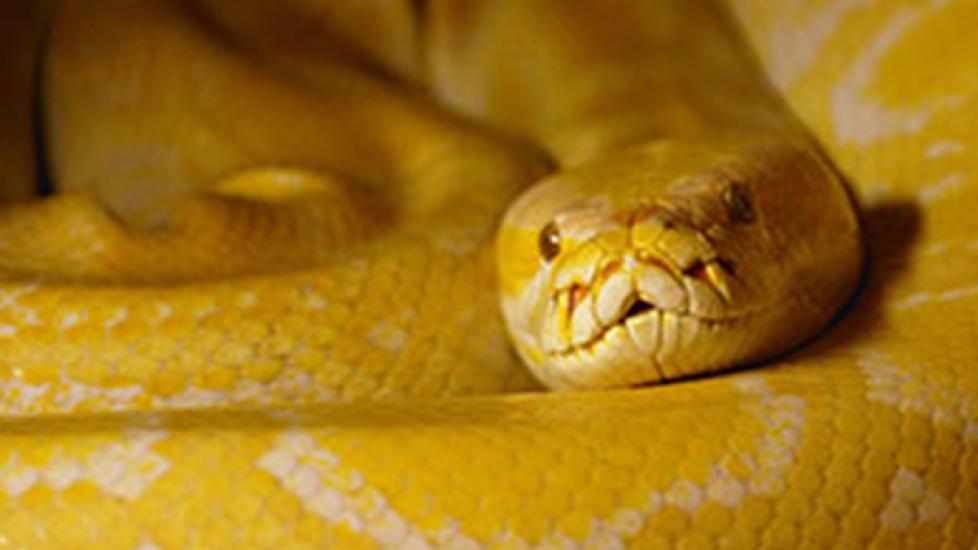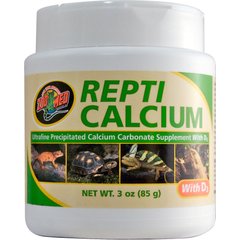Burmese Python - Python bivittatus
Popular Varieties
Until 2009 the Burmese python was considered one of the two subspecies of the Indian Python, but it now enjoys its own classification. The Burmese python has one subspecies: the Python bivittatus progschai, or dwarf Burmese python.
Burmese Python Size
Burmese pythons are one of the five largest species of snakes in the world. Hatchling Burmese pythons average a length of 22 inches (56 cm) and a weight of 4 ounces (113 grams). Female Burmese pythons grow to a larger size than their male counterparts, with the average length of a female Burmese python landing between 13 and 18 feet (4 -5.4 m), though there are reports of female Burmese reaching lengths of more than 19 feet.
The average length of a male Burmese python is still pretty large, between 8 and 14 feet (2.4 — 4.2 m), but can occasionally reach a length of 17 feet (5.1 m). In addition to being one of the largest species of snake, Burmese pythons are also among the heaviest of the giant snakes. A 17-18 foot Burmese can achieve a weight of more than 200 pounds!
Burmese Python Lifespans
The Burmese python is a long-lived snake, with the average lifespan exceeding 20 years. The oldest recorded Burmese python lived to be 28 years and 3 months old.
Burmese Python Appearance
Despite being one of the largest snakes, Burmese pythons are one of the most commonly sold snakes, as well as one of the most beautiful. Typically, Burmese pythons are dark brown with beige blotches and two distinct horizontal lines that run across the head from eye to eye. Burmese pythons do not have as many color morphs as, say, the ball python, but there are a number of established morphs, including the discovery of a dwarf morph. The following are the most common Burmese python varieties and morphs.
Albino
Typical albino Burmese are yellow, white, and orange.
Patternless or Green
Juvenile green or patternless Burmese may retain remnants of pattern, but these will turn to a uniform faded brown, or a dark or khaki green as the snake matures into an adult.
Labyrinth
Nothing to do with the David Bowie movie, the labyrinth Burmese is characterized by a varied and broken maze-like pattern and striping on the first quarter of its body.
Granite
Granite Burmese have light-tan heads, sometimes with a faded brown spear pattern, and their bodies are peppered with a fine, intricate pattern that looks like granite rock.
Dwarf
Though it isn’t necessarily a color morph, the dwarf Burmese python morph offers enthusiasts the option to own a Burmese python that will remain at a manageable size, usually about 5-7 feet.
Level of Care Required for a Burmese Python
Due to their gigantic size, Burmese pythons are not recommended for beginner or intermediate snake owners. There are considerable requirements that need to be satisfied before purchasing a giant snake. For instance, does your lifestyle lend itself to owning a giant constrictor? Do you have small children and pets? Will you be able to handle the adult snake when it grows to be in excess of 100 pounds? Are you prepared to make a commitment that spans multiple decades?
Many giant snakes require two people or more to be present when caring for, cleaning, and feeding the snake. Do you have other people who will be able to help you? A general rule of thumb is that you need one person per 3 or 4 feet of snake.
If you really want a large snake, there are plenty of other species that look awesome, are easy to handle, and don’t grow quite so large, like boa constrictors, rainbow boas, and ball pythons.
Burmese Python Diet
As a rule Burmese pythons are healthy eaters, feeding readily and on a variety of animals. You’ll want to secure a permanent food source for your Burmese before buying one.
A Burmese’s growth rate is also directly related to its feeding regimen. Depending on whether you’re raising your Burmese to breed or not, you’ll need to adopt the right feeding regimen. Power feeding your Burmese for the first two to three years leads to fast growth, which has good and bad points.
Whatever you do for feeding, cutting back on the feeding schedule as the snake’s growth slows is the best way to prevent the risk of obesity. Hatchling Burmese should be given just-weaned baby mice for the first few feedings before moving on to adult mice. Though each snake is different, after that you can move on to this general Burmese feeding regimen:
- From hatchling to 4 feet (1.2 m): Feed one or two appropriately sized mice every 3-4 days.
- At 4 feet (1.2 m) switch to medium rats, then graduate to larger rats.
- From 4 feet (1.2 m) to sexual maturity (10 feet [3 m] in females, 8 feet [2.4 m] in males): Feed one or two prey animals every 5 -7 days.
- By 6 – 7 feet (1.8 – 2.1 m) switch to 3-pound (1.4-kg) rabbits, increasing the size of the rabbit as your snake grows.
- From sexual maturity (appx. 18 months) to three years: Feed one or two rabbits once every week.
- From three years on: Feed one to two rabbits every ten or so days, adjusting your schedule depending on the snake’s overall appearance.
How to Safely Feed Your Burmese Python
Once your Burmese has grown larger than 6 feet (1.8 m) long, you’ll need to adopt safe feeding procedures to prevent injury. These include having prey animals within reach, feeding one snake per cage at a time, and using a snake hook, shield, or wooden board as a buffer when removing uneaten prey.
We recommend feeding your Burmese prekilled prey since live prey can possibly injure your Burmese by biting and clawing. For rabbits, the best method is to ask your supplier to kill the rabbits at the time of purchase. Burmese pythons, as well as every other kind of large snake for that matter, love to eat fowl of any kind. However, even though they love to eat chicken (either raw or live and whole), fowl should only be used as a last resort for fattening a Burmese python that’s reluctant to feed, or to put a little extra weight on a Burmese as part of prebreeding conditioning.
If you want to purchase food in quantity, you can buy pre-killed frozen prey and store them in your freezer. The frozen prey will need to be thawed slowly before feeding your python.
Burmese Python Health
Common Health Issues in Burmese Pythons
Keeping your Burmese happy and healthy is relatively easy; they’re considered hardy captive snakes. But there is one essential husbandry practice that can make the difference between life and death, and that’s heat provision. Burmese will continue to thrive in mildly sub-standard heat with otherwise good care, but a chronic or dramatic lack of heat will suppress their immune systems, making them vulnerable to a host of health issues.
Respiratory Infections
Respiratory disease (e.g., pneumonia) in snakes is a common but easily preventable issue. Most cases of reptile respiratory disease are caused by inadequate heat gradients in the snake’s enclosure. Early stages of respiratory disease will cause snakes to wheeze as they breathe, or they may elevate their heads. A Burmese suffering from an advanced respiratory disease will secrete a foamy substance from its mouth and pouching of the lower throat region. If you see this secretion contact your herp veterinarian immediately. If caught early, successful treatment could be as simple as providing a proper heat gradient. If caught late, your pet may need reptile-safe antibiotics and a full veterinary work-up.
Inclusion Body Disease
Burmese pythons are in the same family as boa constrictors, and boas are considered the primary host for a very serious reptile disease called Inclusion Body Disease (IBD), a retrovirus infection similar to AIDS. It is not contagious to people but is to other snakes. Burmese pythons are extremely susceptible to these types of viruses, especially IBD. Historically, Burmese who are exposed to the virus suffer a dramatic death within a matter of weeks. IBD is marked with symptoms of tremors, seizures, vision loss, loss of tongue control, and the inability to right itself when turned upside down (a condition called “stargazing syndrome”).
Exposure to IBD can happen when infected snakes have mites and the mites transfer infected body fluids onto other snakes during breeding, and by co-habitation with infected specimens. A good rule of thumb is to never house another boa constrictor species in the same cage as a Burmese python.
Burmese Python Disease
Burmese pythons are the main species affected by Burmese Disease (BD), but it has also been seen in Borneo short-tailed pythons, African rock, and blood pythons. BD is a slow, progressive disease characterized by recurring bouts of respiratory infections like pneumonia and involvement of opportunistic bacteria. BD is especially vexing in the herpetoculturist community because there is little to no definitive information about the causes or methods of transmission. Researchers have noticed similarities between BD and IBD, but are unsure whether BD is a new strain of the retrovirus or something new. Affected snakes should be immediately and strictly quarantined, and euthanasia should be considered.
Blister Disease and Scale Rot (Necrotizing Dermatitis)
Often a result of poor husbandry practices, these two conditions can often appear together. Blister disease primarily occurs due to severely inadequate hygiene, and scale rot is caused by a breakdown of the immune system. Snake scale infections can have symptoms that range from mild hemorrhage to severe blistering and ulceration. The result looks almost like a chemical burn in the form of blisters and can take several weeks to heal.
Burmese Python Behavior
Burmese pythons are usually gentle giants, which is one of the reasons why they’re so popular. Hatchling Burmese may be a little nippy, but this will usually settle down and stop altogether after some gentle handling. Other young Burmese may try to squirm away or bite repeatedly and defecate when restrained, and some are plain nasty no matter how much they are handled.
If docility is an important quality in your new pet Burmese, it’s extremely important that you pay attention when selecting your Burmese python in the first place.
Supplies for the Burmese Python’s Environment
Aquarium Tank or Terrarium Setup — Size Matters
With snakes the size of Burmese pythons, makeshift cages and all-glass enclosures simply won’t do. You’ll want to look for an enclosure specifically designed for housing large snakes. The Burmese enclosure should have either a sliding or hinged cover, or a sliding or hinged front with a locking mechanism that will keep your snake from making a great escape. There are several companies that sell molded plastic or fiberglass enclosures with sliding glass fronts that are large enough for housing Burmese pythons, or you can have an enclosure custom built.
Young Burmese snakes can start off in relatively small cages, which has the added benefit of making them feel safe and secure. A good rule of thumb is that the perimeter of a Burmese enclosure should be at least one and a half times the length of the snake. A 75-gallon (284-liter) enclosure is suitable to house a 6-8 foot (1.8-2.4 meter) Burmese. Adult female Burmese pythons require enclosures of at least 72 x 36 inches (181 X 91 cm), and up to 96 inches (244 cm) long for extra-large specimens.
Another option for housing Burmese pythons is framing part of a room to create an insulated glass-front display, kind of like what you see in zoos. Unless you do have an entire room dedicated to housing your Burmese, you won’t be able to use plants for decoration.
As far as substrates go, easy-to-replace is the main goal. You can use aspen shavings, compressed alfalfa (rabbit pellets), fine orchid bark, newspaper, or pine shavings. For decoration, dry landscape materials like large rocks to bask on, sections of cork bark, dried grasses, and large select pieces of wood can be used. Just make sure that anything you put into your Burmese’s enclosure is easy to move and clean (when Burmese pythons eliminate their waste (i.e., urine and stool), they produce copious amounts of liquid and solid.
Heat and Light
The ideal temperature for raising a happy and healthy Burmese is between 85 and 90 degrees Fahrenheit, but consistently maintaining this temperature throughout the enclosure can prove tricky. Using multiple, modern electronic thermometers and combining them with alarms that go off when temperatures drop below a certain level is the best way to ensure proper temperatures are being maintained.
The best system for maintaining proper temperatures in your Burmese enclosure is to provide a daytime air temperature of 84-88 degrees Fahrenheit, with a heated basking area that achieves a surface temperature between 88-92 degrees Fahrenheit. At night the temperature can safely be allowed to drop to between 80-84 degrees Fahrenheit. As long as there’s a basking area available you should be able to avoid all the health issues associated with temps that are too cool.
You’ve got several options when it comes to heating systems, but the main thing to remember is that giant snakes need to be given the opportunity to thermoregulate (self-regulate their body temperature) by having about a third of the enclosure surface heated to 88-90 degrees Fahrenheit. No matter what heat option you choose, take special care to ensure there aren’t any exposed heat elements that could burn your snake.
Listed below are some of your heat source options.
Heat Pads and Tapes
By far the easiest way to heat enclosures, just make sure they’re connected to thermostats and temperature probes.
Pig Blankets
These plastic-enclosed heating pads can only be special-ordered through feed stores and are the best commercially produced heating units for large reptiles. They are large, rigid plastic-enclosed units that emit high surface heat over broad areas. Pig blankets must be controlled with appropriate thermostats.
Ceramic Heaters
These make for a good source of overhead heat; just make sure you select the right wattage bulb for the size of your enclosure and that the ceramic base can handle the wattage. Plastic sockets with cardboard liners will burn after just a few hours. Like every other heat source, using rheostats or thermostats is crucial.
Incandescent Lighting
Incandescents can be used to keep your Burmese warm, just make sure to measure the temperature at the basking area immediately underneath the fixture and at the distance farthest from the bulb after the bulb has been on for at least one hour. Incandescent bulbs must always be on the outside of the enclosure where the light can’t burn the snake.
Space Heaters and Room Heaters
If you’ve got an especially large collection or special snake room, you can use space heaters. Take special care to not let these overheat.
Hot Rocks
While “hot rock” heaters can present problems when snakes curl around them and burn themselves, they can be useful for raising hatchling pythons. Just be careful as it takes a while for a snake to realize that it is on a hot rock. In that time, the hot rock can cause a burn or ulcer on the snake’s body.
Burmese Python Habitat and History
Burmese pythons are native to the Indo-Chinese regions of Borneo, southern China, Hainan, Hong Kong, Java, Burma, Sulawesi, Sumbawa, Thailand, and Vietnam. The Burmese pythons that have been established in captivity in the U.S. originated from Thailand, but in recent years the majority of Burmese imported into the U.S. are from Vietnam and Indonesia.
Unlike other snake species that have been bred to create various morphs, the Burmese python hasn’t been altered too much through breeding. The most significant change in breeding being the achievement of a dwarf Burmese python.
Burmese pythons may seem sluggish in the wild, waiting alongside game trails and rainforest watering holes to grab their prey, but they’re far from helpless. Burmese are actually excellent tree climbers and like to swim and bathe (the water supports their body weight).
Burmese pythons used to be the standard prop of every self-respecting snake charmer, but these days they reside mostly in zoos, nature centers, and on display at pet shops.
Although they are known for being generally gentle and docile, Burmese python populations have created an environmental crisis in South Florida, where they have thrived in the aquatic wilderness of the Florida Everglades. The first sightings of Burmese pythons in the Everglades occurred in the 1980s, but after Hurricane Andrew destroyed a number of zoos, breeding grounds, and wildlife refuges in 1992, allowing a large number of animals to escape into the wild, the numbers of Burmese began to grow dramatically. With few natural predators to keep the population in check, they have since established a large population that continues to grow.
For the South Florida ecosystem, the Burmese are an invasive species that feeds on young crocodiles, birds, and small mammals (some of which are already endangered) like marsh rabbits bobcats, raccoons, opossums, and foxes. There is a valid growing fear that Burmese pythons will soon hunt some native species, like marsh rabbits, into extinction. There have been known attacks on much larger animals as well. In 2006, Florida wildlife researchers found a 13-foot Burmese that had died in the process of attempting to swallow a 6-foot-long alligator, which also died.
The Florida Fish and Wildlife Conservation Commission has responded by holding annual snake removal programs to cull the numbers of pythons and other invasive reptile species, as well as issuing hunting permits to qualified applicants. However, Burmese pythons have been very successful in hiding themselves away in the neutral-toned Everglades that so closely matches their own skin. Of the thousands that are believed to be living in the Florida Everglades, the numbers of pythons caught by trappers and hunters only amounts to hundreds each year.
On the opposite extreme, pythons have been highly sought and hunted for centuries to be used as food, for their prized skins, and for use in various local medical remedies. This overexploitation has landed some species and subspecies on the endangered species list, namely the Indian python and the Burmese python. Despite the Burmese python being listed as protected in Hong Kong, China, and Thailand, it is still extensively and illegally hunted.
This article was verified and edited for accuracy by Dr. Adam Denish, VMD.




